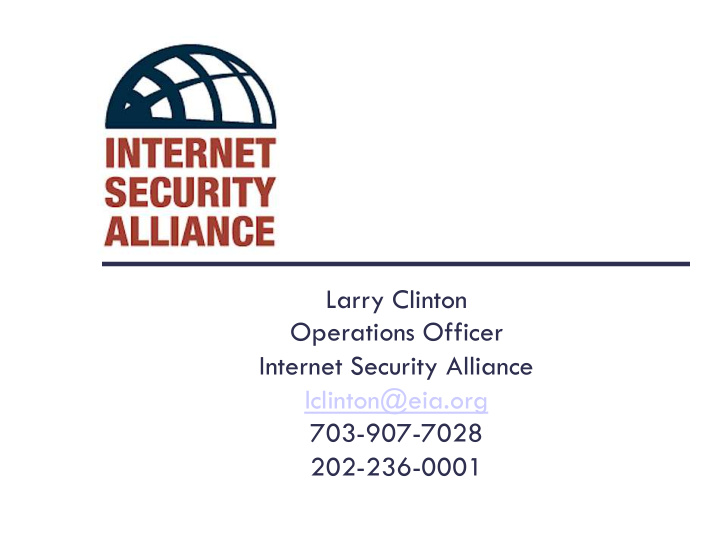



Larry Clinton Operations Officer Internet Security Alliance lclinton@eia.org 703-907-7028 202-236-0001
The Past
The Present Source: http://cm.bell-labs.com/who/ches/map/gallery/index.html
Computer Virus Costs (in billions) 150 $ billion Range Damage 120 90 60 30 0 '96 '97 '98 '99 '00 '01 '02 '03 (Through Oct 7)
III Model Adopted by ISA Fall 2003 1. Tie best practice adoption to reduced costs 2. Tie use of best practice as a prerequisite for access to markets 3. Private/Government use of market to prime the pump 4. Establish climate for market incentives
ISAlliance Incentive Model Model Programs for market Incentives ---AIG ----Nortel ---Visa ----Verizon SemaTech Program Tax Incentives Liability Carrots Procurement Model Research and Development
CISWG Incentive Principles 3/3/04 1. Positive incentives are more likely to generate long term and effective results in cyber security than government mandates. This will ultimately increase consumer and business confidence in the use of technology, promote homeland security and result in economic, cultural and national benefits for all.
CISWG PRINCIPLES 2. Market incentives are likely to be effective: a) leverage industry’s ability to innovate & maintain tools needed for cyber security b) multi-national industry can work globally c) industry can respond to technological change d) ROI approach will attract Sr. Ex commitment e) market programs can work cross industry f) can compliment current sector initiatives
CISWG PRINCIPLES 3. Duplicative and conflicting international, national, state and local requirements create disincentives to effective cyber security
CISWG PRINCIPLES 4. Traditional Regulatory Structures can be ineffective and potentially counterproductive a) International nature of the problem b) Rapid tech change demands flexibility c) Public notice and comment is inconsistent w/ security needs d) Political process encourages compromise e) Gov regulation may blunt innovation
CISWG Recommendation 1.Measurement/Seal of Approval/Certification 1. Continue to base measurement tools on widely accepted best practices 2. Private sector should develop programs of qualification/compliance/certification 3. Private Sector should create designations or award programs (e.g. Baldrige type programs)
2. Insurance 1. Business should make use of risk management programs offered by insurance companies 2. Insurance industry should modify availability and cost of policies based on degree company complies with best practices 3. Government should encourage appropriate availability and use of cyber insurance
3. Market Entry 1. Companies should use market forces to encourage partner security (Visa/Nortel) 2. Industry leaders should identify and encourage such programs 3. Federal Gov. (Congress and DHS) should publicize good actors
What ISA is doing 1. ISAlliance Best Practices Endorsed by EIA, NAM, TechNet, ABA, CERT/cc, USIBC. 2. Work with Global Security Consortium on 3-party measurement based on best practices 3. Establish discount programs based on adoption of best practices. 4. Create “Champion of the Internet” Award for mutual security efforts 5. Expand ROI security programs for Members
Gov. Incentives Liability Protection, Tax, FEMA Congress should consider lowering liability or providing safe harbors to companies who adopt and implement effective IT security controls Congress should consider tax incentives for enhanced security Congress should consider FEMA aid based on adherence to widely accepted best practices
CISWG PHASE II • Liability seems to be growing (e.g. FTC) • California has already established a reasonableness standard • We now need to focus on the next step, how to craft an incentive system
Tentative Conclusions 1. There are not, and may not be consensus metrics/ standards/practices applicable to all. 2. There are an array of measurements across types of organizations that can be used. 3. There are a range of protections to use. 4. There are a variety of organizational mechanisms to set guides. 5. Best approach may be take existing tools and create sliding scale of protections
A new war a new strategy 1. The Internet is a 21 st century technology, it can’t be managed with 19 th century regulatory models 2. The job of securing the Internet with market incentives is much HARDER 3. Creative thinking and market incentives are the best way to win the war in cyber-space
Sponsors
Larry Clinton Operations Officer Internet Security Alliance lclinton@eia.org 703-907-7028 202-236-0001
Recommend
More recommend